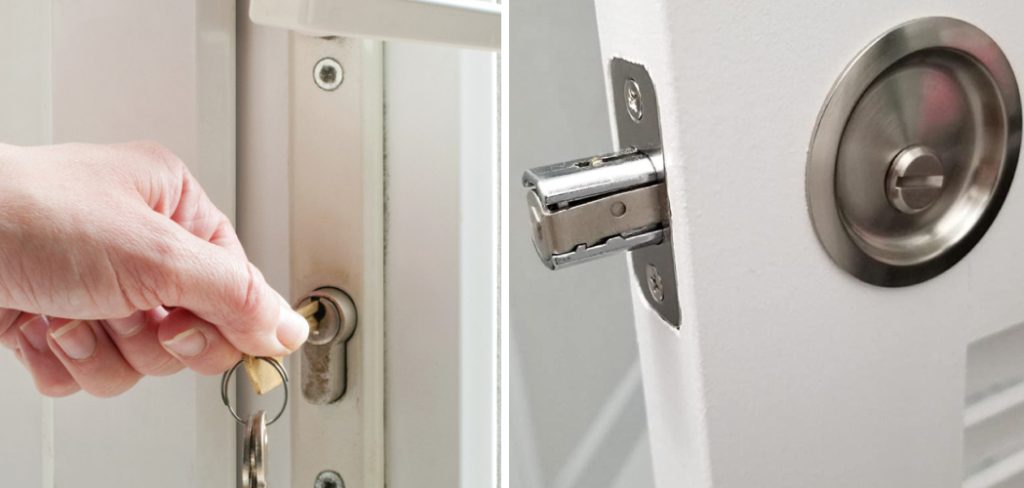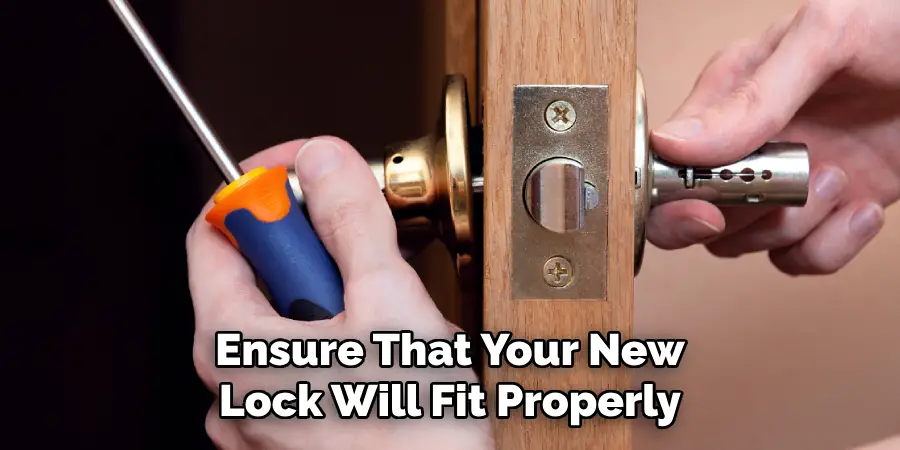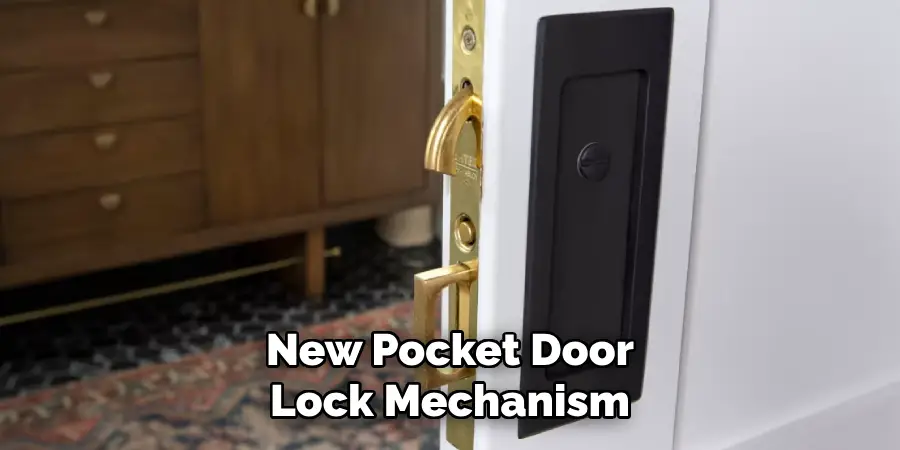Installing a pocket door lock is a vital step in ensuring privacy and security while maximizing space utilization. Pocket doors, with their space-saving design, are increasingly popular in modern interiors. However, to fully enjoy their benefits, knowing how to install pocket door lock is essential. In this comprehensive guide, we will explore the process of installing various types of pocket door locks, from basic edge pulls to flush pulls with locks.

We’ll cover the necessary tools, steps, and considerations, helping you achieve a seamless installation that enhances the functionality and aesthetic appeal of your pocket doors. Whether you’re a DIY enthusiast or a homeowner seeking to add a touch of sophistication to your interior, join us as we delve into the world of pocket door lock installation, offering insights that will empower you to successfully complete this essential home improvement project.
Pocket Door Locks and Their Significance
Pocket door locks are a great way to add security and privacy to your home. They provide an extra layer of protection for the people who live in your home and can help deter potential intruders from entering. Installing one can be relatively easy, but it’s important to make sure you understand how pocket door locks work before beginning the installation process.
Pocket door locks have several advantages over traditional locking systems. First, they don’t require cutting into walls or frames like regular doorknobs; instead, they attach to the existing door trim. Additionally, pocket door locks can be very unobtrusive; since they’re hidden within the cavity of the door, there’s no need for a visible bolt or knob. This makes it more difficult for potential intruders to spot the lock and also takes up less space on the door.
When installing a pocket door lock, you’ll want to make sure that you purchase a model compatible with your type of door. You’ll also need to measure the space inside your pocket hole in order to ensure that your new lock will fit properly. Once you’ve bought the correct lock, you can start the installation process.

Importance of Proper Installation for Security and Privacy
Installing a pocket door lock correctly is essential for ensuring your security and privacy in any home or commercial setting. It’s important to understand the steps involved in installing a pocket door lock so that it can provide long-lasting protection against intruders and potential theft.
However, it should be noted that incorrect installation of a pocket door lock can lead to serious issues such as break-ins and compromise the safety of you and your family.
To install a pocket door lock correctly, you must first measure the thickness of the door panel. You will need to pre-drill holes in the frame for mounting the pocket door lock. Next, attach the latch plate to the pocket door. Once that is secured, you must ensure that all components of your pocket lock are properly mounted and aligned on both sides of the door.
Once you have followed all these steps, it’s important to test whether or not the door locks securely. You should also check if there’s any play in the mechanism when locking or unlocking the door. If there is, you should make adjustments accordingly to ensure that the lock will be as secure as possible in its installation. You can also use a jamb strike plate and reinforced screws to further strengthen the overall security of your pocket door lock.
10 Methods on How to Install Pocket Door Lock
1. Measure the Thickness of the Door
Before you can install a pocket door lock, you will need to measure the thickness of the door. This will help you determine what type of lock you will need to purchase, as some locks are designed for thicker doors and others for thinner doors. You should also measure the width of the door so that you can ensure that your chosen lock is wide enough to fit your particular door.

2. Pre-Drill Holes
Once you’ve measured your door, it’s time to pre-drill holes in the frame and wall for the lock. When drilling into drywall, use a drill bit that is slightly smaller than the screws that will be used to secure the lock in place. If drilling into wood, use a drill bit that is slightly larger than the screws so that they have room to expand once they are inserted into the wood.
3. Install Strike Plate
Next, install a strike plate on the inside of your pocket door frame using screws and anchors if necessary. The strike plate should be positioned so that it lines up with where your pocket door lock will be installed on the other side of the wall or frame. Make sure all screw heads are flush against their respective surfaces before moving on to step four.
4. Attach Lock Mechanism
Now it’s time to attach your pocket door lock mechanism onto your pocket door frame or wall using screws or nails, depending on which type of material you are working with (wood or drywall). Make sure all screw heads are flush against their respective surfaces before moving on to step five.
5. Connect Lock Components
Once all components have been attached, connect them together according to manufacturer instructions and make sure everything is securely fastened in place before testing out your new pocket door lock mechanism for functionality and security purposes. If any components feel loose or don’t seem secure enough, tighten them up as needed before proceeding any further with the installation process.

6. Insert Key Cylinder
Insert the key cylinder into the pocket door frame or wall according to manufacturer instructions and make sure it fits snugly into its designated spot without any wiggle room left around the edges or sides of the cylinder itself; this will help ensure optimal security once installed correctly and completely assembled later on down line after all other steps have been completed successfully first!
7. Secure Lock Body
Secure lock body onto pocket door frame or wall using appropriately sized screws (or nails) depending on what type of material is being worked with (wood/drywall). Make sure all screw heads are flush against their respective surfaces before moving onto the next step in the installation process: attaching trim pieces onto the outside surface area surrounding the newly installed locking mechanism itself!
8. Attach Trim Pieces
Attach trim pieces onto the outside surface area surrounding the newly installed locking mechanism itself using appropriate-sized screws (or nails) depending on what type of material is being worked with (wood/drywall). Make sure all screw heads are flush against their respective surfaces before moving on to the next step in the installation process: inserting the keyed cylinder into the newly installed locking mechanism itself!
9. Test Out Lock Functionality
Test out the newly installed locking mechanism by inserting the keyed cylinder into its designated spot and attempting to turn the knob/lever handle from both inside and outside areas; if everything works properly, then proceed to the final step: ensuring optimal security by making sure no wiggle room is present around edges/sides when the keyed cylinder has been inserted correctly into its designated spot within locking mechanism itself!
10 Ensure Optimal Security
Ensure optimal security by making sure no wiggle room is present around edges/sides when the keyed cylinder has been inserted correctly into its designated spot within the locking mechanism itself; this will help prevent any potential tampering attempts from occurring while also providing maximum protection for users belongings stored behind locked doors at the same time!
Some Common Mistakes to Avoid
Installing a pocket door lock should be an easy job. However, there are some common mistakes that people make when installing this type of lock. Here are some tips to ensure your installation is successful:
- Make sure you have all the necessary tools and supplies for the job before beginning. This includes a drill, screws, a door latch, and a pocket door lock.
- Measure twice and cut once! Make sure to measure the door frame twice before cutting it to ensure an accurate fit for your new pocket door lock.
- Don’t rush! Take your time when installing the pocket door lock to make sure everything is lined up correctly and that all pieces are secure.
- If you’re not familiar with how the pocket door lock works, it’s best to consult an expert before attempting installation.

Conclusion
In conclusion, pocket door locks can be a great way to add extra security to any space. With the proper tools and instructions, you’ll be able to quickly and easily install one in no time. Remember that the exact process will depend on the type of lock you are using, so make sure you know exactly what you are doing before beginning your project.
And if you’re not sure how to proceed at any point or have any general questions about installing a pocket door lock, don’t hesitate to reach out to an experienced professional for assistance. Now that you know how to install pocket door lock, why not give it a go? You may just find that this minor undertaking is well worth the effort!
